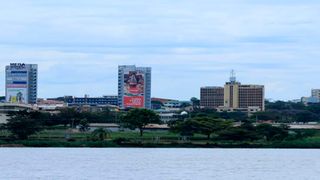
Part of Kisumu City skyline overseeing the Kisumu Port in Lake Victoria in this photo taken on October 20, 2019.
| Jeff Angote | Nation Media GroupKisumu
Premium
How Kisumu’s skyline has changed in 10 short years
For 83-year-old Mzee Odungi Randa, who has seen Kisumu transform from a colonial-era dusty town to a booming city, he has lived in two worlds.
Mr Randa, a second liberation hero, worked as an aide to the first vice-president of Kenya, Jaramogi Oginga Odinga, and still goes to his office in the backstreet of the city.
It is a busy street, a far cry from what it used to be decades ago.
While it was not buzzing with activity as it is now, Mr Randa narrates that the street was one of the few that had restaurants and ‘beautiful’ buildings in the 60s.
“During those days, we had fewer buildings, mostly in the lower part of the town. For you to reach the next eatery, you had to walk a very long distance but now the streets are dotted with all kinds of prestigious restaurants,” said Mr Randa.
Storey buildings
He said that in the 1950s, there were hotels such as Kamur, Marina, Victoria and Kai where prominent people including Jaramogi would host meetings.
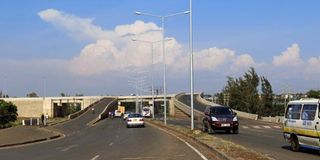
Vehicles heading to various destination crisscross Nyamasaria Airport bypass in Kisumu on July 26, 2016.
One of the first storey buildings in Kisumu was Alpha House, now Prudential House, whose foundation was laid by the late Bishop John Henry Okullu of the Anglican Church, a fierce critic of the government in the 1990s.
“When the building came up, it was one that attracted many of us who were used to the low-rise ones. Today, the town has changed and we hope many more investors will put up more to rival the capital Nairobi,” said the Luo elder.
A visitor to Kisumu 10 years ago would find a totally different city –from the buildings to the streets and the walkways.
Most of these buildings had Asian architectural designs, serving as hotels, shops and residences, but they have been replaced by skyscrapers and other towering structures that have changed the lakeside city’s skyline.
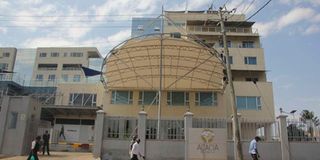
The Acacia Hotel at the Westend Mall in Kisumu.
When flying into the city or looking at it at night from the Riat hills, the view is breathtaking.
They range from commercial buildings to prestigious hotels, learning institutions and malls.
One Kentons building
The latest sensation is the well-lit One Kentons building at the heart of the city on Oginga Odinga Street. It was completed late last year and is already housing banks and offices.
Next to it is the 55-bed Imperial Express Hotel, conveniently located at the centre of the city with a unique architectural design.
The three-floor facility is another arm of Imperial Hotel on Jomo Kenyatta Highway that for a long time was among the few that flourished in the lakeside city. Both hotels are owned by Mayfair Holdings Ltd.
It has since been refurbished and is among many hotels, alongside Acacia Premier, that stand out and illuminate the streets around them. Its aqua pool bar gives you a spectacular view of the lake and the city.
It sits in the famous Westend Mall that houses the Chandarana supermarket, Java Coffee House, Aga Khan Hospital, Woolworths and other outlets.
Other shopping malls that have come up include the Tuffoam on Jomo Kenyatta Highway. It hosts several fast-food joints and other restaurants, a nightclub and banks.
Another is United Mall on the Kisumu-Kakamega road. It hosts internationally known supermarket chain Carrefour, Java Coffee House, banks, fast-food joint KFC and other outlets.
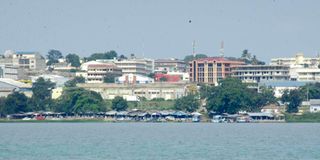
Kisumu City.
Then there is the Lake Basin Development Authority (LBDA), conveniently located near the Mamboleo junction on the Kisumu-Kakamega highway.
Though it is yet to attract major clients, the 60,000-square-metre shopping complex has the main Kenya Revenue Authority offices as well as the contemporary Best Western Hotel, whose rooms give guests a beautiful view of the city.
Kisumu is oversupplied by 200,000 square feet, according to the 2018 Kenya Retail Sector Report, yet additional mall spaces are coming up, a factor that is turning out to be an advantage for those looking to rent space.
In 2017, the face of the town changed following the completion of the Mega Plaza Twin towers. Each of the 63-metre towers has 17 floors and the glittering glass walls are a spectacle.
It houses various companies, including the Nation’s bureau office, anchor tenants such as Carrefour and others.
It is not just commercial buildings dotting the Kisumu skies but also learning institutions such as Maseno University’s Town Plaza, which is 52 metres tall and has 14 floors. It was recently repainted and is attractive.
Barely 20 metres away is the University of Nairobi building, on Oginga Odinga Street, with dark blue glass walls.
The tower block is designed to blend well with the existing British Council building that is a protected historic monument and used to be a library and hosted theatre activities.
It has six floors, but the original plan had 16 floors, which were to be constructed in two phases. The completed first phase comprised a six-storey campus complex, a podium block and one split basement car parking floor.
It also has lecture and seminar halls as well as an amphitheatre, a library and an office block.
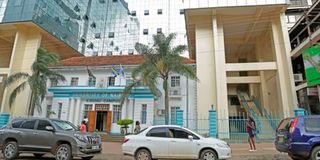
University of Nairobi – Kisumu campus with the lower untouched structure of the former iconic British council building along Oginga-Odinga Street in Kisumu on January 28, 2020.
The additional 10 floors, which were not built, were to carry more lecture and seminar rooms, computer science labs, a cafeteria, administration offices, vice-chancellor’s office and a board room.
Property developers in Kisumu attribute the changing skyline to increased investor confidence in the lakeside city.
Ms Nishma Karia, director of Lake Estate Agency Ltd, feels the growth of Kisumu estates has been fuelled by the ongoing development projects in the city, especially the development of the lakefront.
Other development projects that have attracted investors and changed the city are the newly refurbished Kisumu port, the rehabilitated Nakuru-Kisumu railway line, and various major roads.
“Kisumu … remained untapped for a very long time. What has catalysed the growth is the improved infrastructure such as roads within the city centre and the big projects such as the development of the lakefront, which is attracting many investors,” she said.
Rising population
She said for property developers, Kisumu is key because it is the economic hub of the East African Community.
Coupled with a rising population, the demand for office spaces and residential buildings is high.
But she said investors need to be given certain incentives.
“As an incentive to investors, the county government should make approval of construction designs easier and faster. They should also not limit the number of floors a particular building must have,” she said.
However, there are still decades-old buildings that dot the city centre, mostly acting as residential homes for Asians, something that may be barring potential investors from high-rises in the area.
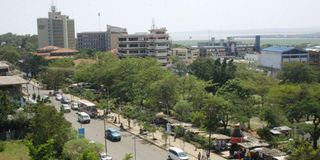
A view of Kisumu City from Jomo Kenyatta Highway.
But acting Kisumu City Manager Abala Wanga told the Nation that there are many heritage buildings along Oginga Odinga Street whose owners have been asked to renovate and paint while maintaining their heritage and design.
“As we approach the ninth Africities summit, which will be held in Kisumu, we want to ensure all buildings within the CBD are painted with brown-beige colours. The city management will secure a waiver on the approval fees to owners of the buildings,” he said.
Road kerbs should be painted in a mixture of blue and white.
Commercial buildings
Apart from commercial buildings, there are also the leafy suburbs of Milimani estate, which was originally meant for low-rise houses but has slowly metamorphosed into a high-rise apartment area.
This too is being discouraged by the city, with approvals being limited at fewer floors in Milimani and Riat Hills.
The city will also not approve buildings that go further than eight floors in the City centre.
“We will only approve construction of houses (in Milimani) with a ground floor and a maximum of two storeys. We do not want Milimani to lose its shine and become one crowded area. This was not the original design for the upmarket location,” Mr Wanga said.
He feels the high-rise buildings in Milimani are disturbing the water flow and drainage system.
Luo elder Mr Randa feels that more structures should be put up outside the city to grow the whole county.
“We want these investors and property developers to venture outside the town centre and have these tall buildings in Ahero, Maseno, Katito, Muhoroni and Kombewa to complete the city’s new look,” he said.
He confirmed plans are underway to expand the city centre even more and this would mean some facilities such as the Kisumu Bus Park, Kisumu School and Kisumu Girls High School will have to give way. They are to be relocated to Kibos, where a major industrial park is to be established on 105 acres.





